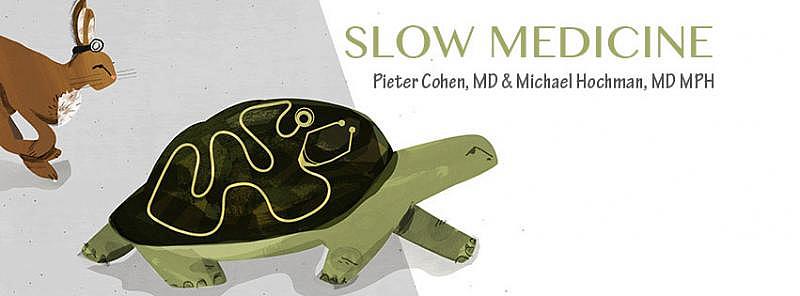Overkill: Gawande on America's epidemic of unnecessary care

Atul Gawande.
Many of our colleagues and readers have been asking for our take on Atul Gawande's latest New Yorker piece on unnecessary care.
In a nutshell, it’s fabulous. As always, Gawande intertwines personal stories, patient stories and expert interviews to great effect in making the Slow Medicine case. Here are some highlights that caught our attention:
1) We loved the analogy of turtles, birds, and rabbits for describing why screening tests often don't work (credit Gilbert Welch from Dartmouth who developed the analogy). To summarize, the goal of screening tests is to catch potentially deadly diseases like cancer before they “escape the barnyard pen.” Such an approach may work to prevent rabbits from escaping: If you see them start to make a break, you may be able to stop them in time. But it doesn't work so well for birds, who fly away no matter what you do. And it isn't necessary for turtles, who aren't going anywhere fast. How does this relate to screening tests? Turns out most diseases, like cancer, act more like turtles (think prostate cancer) and birds (think pancreatic cancer) than rabbits, which explains why many screening tests which intuitively seem so important are often ineffective in preventing the clinical outcomes we most care about.
2) Gawande proposes three reasons why clinicians provide care of low or no value: A) it enhances our income; B) it’s our habit; and C) we “genuinely but incorrectly believe in it.” We agree these are the three important drivers, but we suspect that in many settings – particularly where clinicians are salaried – culture and habit are the biggest drivers. In the U.S. we've gotten used to practicing an aggressive style of medicine, and we sometimes equate doing more with providing better care. For a concrete example of how this happens, consider this great essay by Diane E. Meier about an oncologist who felt that not offering chemotherapy to a dying patient was tantamount to abandoning her.
3) Gawande tells the poignant story of a man with chronic back pain who is set to go under the knife for spinal fusion until his employer sends him for a second opinion to a “best practices” medical center. There they treat him with back exercises, medications for neuropathic pain, spinal injections, and relaxation techniques. Soon he improves. The mistake the first surgeon made was not only jumping immediately to surgery but also failing to utilize appropriate conservative strategies. Gawande writes: “It isn’t enough to eliminate unnecessary care. It has to be replaced with necessary care. And that is the hidden harm: unnecessary care often crowds out necessary care, particularly when the necessary care is less remunerative.”
4) Gawande speaks favorably about reforms in the Affordable Care Act that align incentives to promote appropriate care rather than simply “doing more.” He describes early successes with accountable care organizations and other payment reforms that reward high quality efficient care, including in McAllen, Texas (the community that Gawande famously highlighted in his piece several years ago describing regional variations in care). According to Gawande, the most successful reformers in McAllen have achieved better outcomes at lower cost by promoting team-based primary care and linking clinician bonuses to cost-savings and high quality outcomes.
We are a bit more reserved than Gawande about the impact of these changes: There is little evidence thus far to suggest that payment refers promoted by the ACA will truly shift the culture of medicine toward a slower practice. We'd prefer to see a single-payer system that could rapidly and effectively realign incentives across the board. Nevertheless, many good people are working hard to promote care transformation as part of ACA reforms, and perhaps they will have some success.
5) Gawande cautions that although there is plenty of wasteful care to cut, incentivizing parsimonious care could ultimately go too far, as it did during the "managed care revolution" of the 1990s. At some point, further reductions will lead to cuts in appropriate and necessary care. We would add that sometimes efforts to eliminate wasteful care simultaneously lead to cuts in appropriate care, particularly when such care (e.g. conservative approaches for managing back pain) is poorly reimbursed. We believe it will be important to keep a close watch on this as new payment models such as accountable care organizations take off.
6) Gawande concludes the piece with a story about a woman with an incidentally discovered microscopic cancer of her thyroid. Gawande counsels her that this tiny cluster of abnormal cells is almost certainly harmless (in fact, he wishes there were a better word to describe it than cancer). Despite his recommendations, she wants to proceed. Bearing all, Gawande shares that he performed the surgery despite believing it was not the best course of action because, he explains, “the idea of tracking a cancer over time filled her with dread.”
Gawande concludes the article with this:
She thanked me profusely for relieving her anxiety. I couldn’t help reflect on how that anxiety had been created. The medical system had done what it so often does: performed tests, unnecessarily, to reveal problems that aren’t quite problems to then be fixed, unnecessarily, at great expense and no little risk. Meanwhile, we avoid taking adequate care of the biggest problems that people face — problems like diabetes, high blood pressure, or any number of less technologically intensive conditions. An entire health-care system has been devoted to this game. Yet we’re finally seeing evidence that the system can change—even in the most expensive places for health care in the country.
Did Gawande cave to pressure? Some might argue so, but this case was a close call and given the patient’s anxiety we think proceeding with surgery was the right decision. In grey areas like this (and there are a lot of grey areas in medicine), it is patients – not the health care system – who should drive the direction of care.
But the larger lesson here is that too often our system guides patients down a path leading to unnecessary at times harmful care. We believe promoting the Slow Medicine philosophy could go a long way towards reducing this waste.
Dr. Rachael Bedard contributed to this post.
Photo by Amar Karodkar via Creative Commons license.


